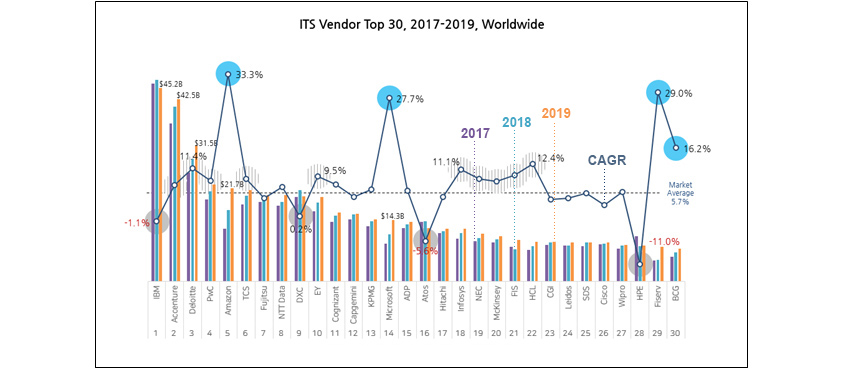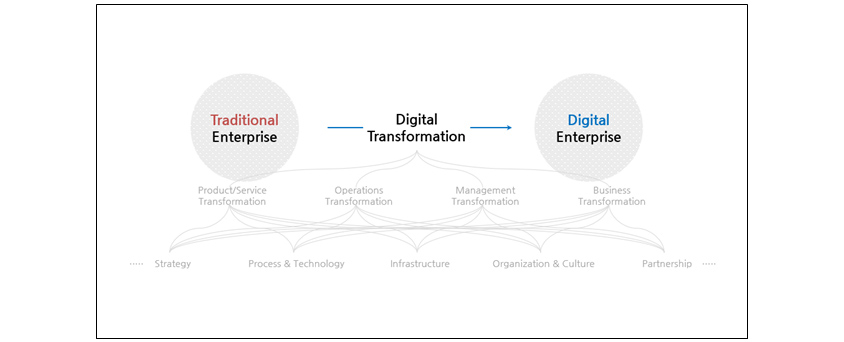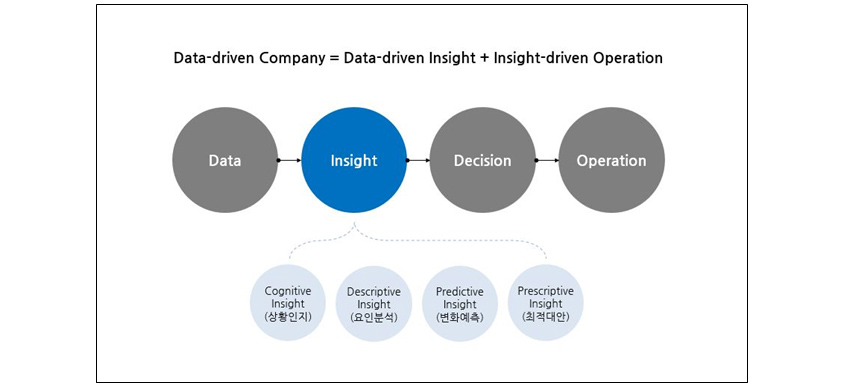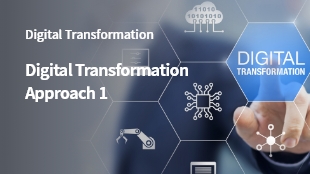
We will discuss the topics of digital transformation, which is now a familiar concept and promoted by many companies (in this issue), and how to promote digital transformation (in the next issue). In this issue, we will explain the concept of digital transformation in four keywords starting with D.
1. The Emergence of disruption
In the 2010s, companies so-called disruptors emerged in various industries across the world. Around 2015, Disruptors, including Airbnb, Uber, Netflix, Tesla, and AWS, started to take everyone’s attention on their disruptions. Seven years later, companies and customers worldwide spend more money on these disruptors than before.
Take the IT services industry, where I, directly and indirectly, belonged. In the 2000s, the global IT services industry was led by American Consulting & SI companies, including PwC and Deloitte, challenged by low-cost Indian IT services companies. However, strong disruptors emerged and started to make changes in market dynamics in the mid-to-late 2010s.

- 2017-IBM:$46,00, Accenture:$38,00, Deloitte:$25.00, PwC:$18,00, Amazon:$13,00, TCS:$17,00, Fujitsu:$18,00, NTT Data:$16,00, DXC:$19,00, EY:$16,00, Cognizart:$14,00, Capgemini:$15,00, KPMG:$13,00, Microsoft:$19,00, ADP:$12,50, Atos:$13,50, Hitachi:$11,00, Infosys:$10,00, NEC:$9,00, Mckinsey:$8,50, FIS:$7,00, HCL:$6,00, CGI:$8,00, Leidos:$9,70, SDS:$9,70, Cisco:$9,90, Wipro:6,00, HPE:$11.50, Fiserv:$3.00, BCG:$4.00%
- 2018-IBM:$47,00, Accenture:$40,00, Deloitte:$27.00, PwC:$20,00, Amazon:$17,00, TCS:$19,00, Fujitsu:$19,00, NTT Data:$18,00, DXC:$20,00, EY:$18,00, Cognizart:$17,00, Capgemini:$17,00, KPMG:$15,00, Microsoft:$11,00, ADP:$13,00, Atos:$13,60, Hitachi:$11,50, Infosys:$11,00, NEC:$11,00, Mckinsey:$10,50, FIS:$6,00, HCL:$7,00, CGI:$9,90, Leidos:$9,70, SDS:$10,00, Cisco:$9,90, Wipro:9,70, HPE:$9.70, Fiserv:$3,00, BCG:$4.50%
- 2019-IBM:$45,2B, Accenture:$42,5B, Deloitte:$31.5B, PwC:$22,00, Amazon:$21,7B, TCS:$20,00, Fujitsu:$20,00, NTT Data:$20,00, DXC:$19,00, EY:$18,50, Cognizart:$18.50, Capgemini:$17,10, KPMG:$15,50, Microsoft:$14,3B, ADP:$13,50, Atos:$12,00, Hitachi:$12,00, Infosys:$12,00, NEC:$12,00, Mckinsey:$11,50, FIS:$10,00, HCL:$10,00, CGI:$10,00, Leidos:$10,00, SDS:$10,00, Cisco:$10,00, Wipro:9,70, HPE:9.70%, Fiserv:$6,00, BCG:$5.00%
- CAGR-IBM:-1.1%, Accenture:7.0%, Deloitte:11.4%, PwC:8.0%, Amazon:33.3%, TCS:8.0%, Fujitsu:4.7%, NTT Data:6,0%, DXC:0.2%, EY:$9.5%, Cognizart:7.0%, Capgemini:5.5%, KPMG:5.8%, Microsoft:27.7%, ADP:5.75%, Atos:-5.6%, Hitachi:5,3%, Infosys:11.1%, NEC:9%, Mckinsey:8.8%, FIS:9.0%, HCL:12.4%, CGI:5.3%, Leidos:5.3%, SDS:5.6%, Cisco:4.0%, Wipro:5.8%, HPE:-11.0%, Fiserv:29.0%, BCG:16.2%
(Source: IT Service Market Share in 2017-2019. Gartner, annual report of each company, and press release)
[Figure 1] shows the revenue and growth rate top 30 global IT services companies from 2017 to 2019. The market grew by an average of 5.7%, while AWS, Microsoft, and Fiserv, Inc. recorded higher growth rates of around 30%, emerging as disruptors in the global IT services market. The parent company of AWS, Amazon, is a major company in the retail industry, as Microsoft is in the software industry, and Fiserv in the business process outsourcing (BPO) sector.
These disruptors represent higher growth than the previous strong companies (some of them were called unicorn) and are considered to have higher market values. Their emergence made the traditionally strong companies tense, and industries were concerned about their survival if they did not change.
2. The emergence of digital transformation
"Change yourself, or you will die." We often hear the saying. However, Gartner described the core of the risk brought by those disruptors is that "they already raised the expectations of customers and changed consumption behaviors. (Shift of fundamental expectations and behaviors.)” The world has changed, and if you can’t adapt to the change, you may be eliminated.
"Change to keep up with disruptors." Digital transformation is not limited to low-cost, high-efficiency, and new products and services, but creating new robust customer experiences, changing the company's foundation, and eventually transforming into a competitive digital company. Of course, there are various definitions for digital transformation. Therefore, we will go through a few definitions of major influencers.
McKinsey defines it, stating that “it will change the key areas of business and find new values to plan based on predictions, produce with automated methods, and recognize circumstances to respond to customer needs. It also builds fundamental digital capabilities that enable changes in work culture, information systems, and the capabilities to use new technologies.”
Accenture's definition is “to innovate the source of the business competitiveness business model, management model, and labor using digital characteristics to thrive in the competition with disruptor (or unicorns) born by digital technologies, and to gain competitiveness to the current business model and prepare for future business.”
Microsoft defines it as “Making use of digital technologies to turn existing products, services, and business processes into highly connected products and data-driven processes. and a process of fundamental and radical change, creating visible performances by offering new customer experiences, saving costs through improved operational efficiency and, in addition, ensuring a new business model by doing so.”
In short, digital transformation is “changing the entire business system, including the business model, products and services, processes (operational methods), initiative, system, and culture (management methods) for a new customer experience, i.e., "for a new customer experience, through a business system all through digital technology.” [Figure 2] Shows the definition of digital transformation (digital transformation initiative) from the World Economic Forum that first introduced the concept of global business. In a nutshell, digital transformation is transformation from a traditional company to a digital one.

- traditional enterprise -digital transformation -> digital enterprise
- product service transformation -operation transformation - management transformation - business transformation
- ...... strategy - process & technology - infrastructure - organization & culture - partnership ......
(Source: “Digital Transformation of Industries: Digital Enterprise,” WEF 2016, etc. (Organized by S-Core))
3. What is digital enterprise?
Earlier, we explained digital transformation as the idea of transformation from a traditional company into a digital company. That is not surprising at all. However, that is not the end of it. We need to figure out what digital enterprise is.

- • Smart Factory: Siemens
- • Auto Warehouse: Amazon
- • IoT Machines: GE
- • Global Quality Control: Apple
- ……
- • AR Theme Park: Disney
- • Collaborative Robots: ABB
- • Digital Insurance: Allstate
- • Connected Car: Tesla
- ……
- • Cloud Service: AWS
- • Mobility Service (Reach Now): BMW
- • Connected Field Service: Philips
- • OTT: Disney
- ……
Besides digital natives, the companies in [Figure 3] are considered digital companies with successful new management methods, products, services, and businesses. Recently, companies in America and in Asian countries, including Korea, Japan, and China, have shown various digital transformations.
What kind of characteristics do these companies share, then? Surveys from key opinion leaders (McKinsey, BCG, Kearney, etc.) show (the full text is not included in this article for limited space) four shared characteristics, which are summarized in [Figure 4].

- Proactive - Quick recognition and prediction of changes in demand and supply
- Automated - Automated supply process to utilize control and modify
- Contextual Interactive - Customized interactions on the markets and customer's characteristics
- Flexible - Flexible organization, cloud infrastructure, and digital assets
(Source: McKinsey, BCG, Kearney, PwC, Bain & Company, IBM, Microsoft, IDC, Deloitte, etc.)
Many specialized companies explain the digital company is proactive of market changes (proactive), produces with an automated process (automated), responds according to customers' characteristics (contextual interactive), and has digital technology, infrastructures, and flexible organization (flexible). They say the key to obtain such characteristics is how we handle data. If companies proactively plan or automate from purchases and the production to quality control processes through predictions or classify customers and understand the context, all those are impossible without data.
S-Core defines the digital company as a data-driven company using various data and digital technologies obtained from internal and external sources to enable quick recognition in each area of their value chain, predict future directions through collective analysis, and take a quick application of the best alternatives.
[Reference article] Samsung Electronics Declares Itself a "Data Company” at Silicon Valley (Maeil Business Newspaper, October 12, 2017)
4. So what is a data-driven company?
We explained that digital transformation is becoming a digital enterprise. This is easy to understand. However, the more we learn about what is a digital company, the more we get confused. Is a digital company a data-driven company? Let’s take one last step further. What is a data-driven company?
“Run” refers to all activities, including research, development, purchasing, manufacturing, sale, service, and planning. These activities are performed based on numerous “decision-making” moments. Running by data means collecting data to extract the required information, make decisions based on the information, and practice according to those decisions. Although the information here varies depending on the decisions companies made (by borrowing the term from the data & analytics industry), however, generally, it means information about the current situation (descriptive and cognitive), information about the causes and future situations (diagnostic and predictive), and information about future responses (predictive).
The information is based on a significant amount of data and insightful analysis rather than a few data combinations. Therefore, it is not called information but insight into the industry. So, the meaning behind the phrase a “data-driven company is run by data” is that the “data-driven company makes decisions according to the insights from processed data and takes applicable measures (data-driven insight, insight-driven operation).”

- data -> insight(cognitive insight( Recognize situations), descriptive insight(Analyze factors), predictive insight(Predict changes), prescriptive insight(Offer the Best alternatives))-> decision -> operation
However, creating insights and making a decision is more complex than the saying. It is not simple at all. What data should we collect? How is meaning extracted from data? Does the insight we put our efforts into decide the various directions of business activities? Is it okay to run as is? Other questions also keep filling your head. In a way, you don’t have any idea what data is needed, and your company lacks the technologies to handle the data and infrastructure to store vast amounts of data. Even though insights have been established based on data, they will be disagreed over by skilled leaders and upper management who would rather believe in their intuition.
The disagreement means there will be numerous inhibitors on the way to the operation. Such inhibitors can be from required technology, infrastructure, quality, technology, and policy to mindset, and work culture, which also means when such inhibitors are enabled, then digital transformation may succeed.
S-Core calls the factors enabling digital transformation as digital capabilities of the company. Let’s draw the previous [Figure 5] again with digital what we found. Like [Figure 6], we can explain the data-driven company model with digital operations on the way to Data to Operations and digital capability to enable such.

- 내/외부 data source(social,market,customer,product,internal IT, physical infra,partners, ...)
- insight - (digital operations) - cognitive insight( Recognize situations), descriptive insight(Analyze factors), predictive insight(Predict changes), prescriptive insight(Offer the Best alternatives)
- digital operations : data -> insight -> decision -> operation
- digital capability(enabling disabiling levers) : ... digital technology policy, rule & process workplace talent & skills organizational culture ...
- example of digital operations(Demand Forecasting, Products/Services Development, Proactive Purchase, Strategic Partnership, Production/Operational Automation, Digital Marketing, Customer Relationship Management, ...)
5. Epilogue
In summary:
“Digital transformation means becoming a digital company from a traditional company and a digital company means being run by data, which is a digital driven company. Data-driven company refers to a company that finds insights in the data and makes decisions and practices the insight. To realize, it should ensure digital capabilities, including technology, infrastructure, labor, work culture, etc.”
Many of you might have heard of or known the concept without processing it before. We hope this article helps you understand and organize the overall concept of digital transformation in your head. In the next issue, we will discuss “How to turn a company into a data-driven company.” That is, how to start the digital transformation journey.
▶ The content is protected by the copyright law and the copyright belongs to the author.
▶ The content is prohibited to copy or quote without the author's permission.

Strategic Process Innovation Team, Consulting Business Unit, S-Core Co., Ltd.
A senior consultant of the S-Core Consulting Division for implementing high-tech, IT services, the technology convergence industry, digital business, digital technology based new business, and digital transformation strategies.
